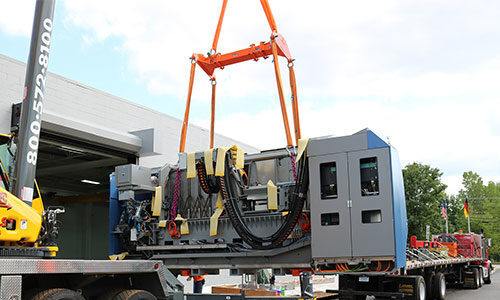
Heavy Rigging Done Safely
Create a safe heavy rigging experience at your workplace by working with Commercial Construction Incorporated. At CCI, we understand the crucial reasons to follow the latest in lifting and rigging best practices. Learn how we provide safe and efficient services today to reduce the risk of a workplace hazard.
Heavy Rigging Best Practices
Lifting machinery, equipment and other items with heavy rigging is a particularly dangerous activity. Our rigging team uses mobile cranes, heavy industrial forklifts and various rigging to keep your project moving forward. We continue to provide our team with the latest in rigging education to ensure these and other best practices are followed. Here are a few ways we perform heavy rigging safely.
Communication
Heavy rigging and lifting operations are fundamentally dangerous. Along with comprehensive planning and risk assessment, clear communication is extremely important for maintaining safety on worksites. In fact, it only takes a single miscommunication to cause a catastrophe. For example, if an operator misinterprets a hand signal, that small misinterpretation can lead to injuries, massive property damage, and even fatalities.
When handling heavy rigging projects for clients, our team at CCI Industrial Contractors is well-trained on communication and safety. Additionally, we also create a thorough plan that outlines potential hazards and establishes consistent communication standards.
Create a Plan
A rigging project can be routine or a complex logistical problem that requires precise lift planning. Very often, machinery and equipment are being lifted during live production. Improper planning could create unnecessary risks. Our written plan typically includes the following information:
- Goal of rigging
- Load weight, center of gravity, angles, and lifting plan
- Capacity and efficiency of chosen rigging equipment
- Travel area and lines of fire
- Potential workplace hazards and mitigation plans
Maintain the Equipment
Another critical step before any load is lifted is a complete equipment inspection. This helps prevent a maintenance issue or causing a workplace accident. Every piece of equipment should be inspected and serviced before use.
Inspect the Area
The written plan already includes a detailed description of the work area and any potential hazards, but our team still ensures the area is clear and ready for the operation. An area inspection can include a review of any potential obstructions and verification of the foundation the crane or forklift will operate on.
Choose the Optimal Sling and Hitch Configuration
There are many different ways to secure a load before lifting it. A key area of heavy rigging best practice is understanding the available hitching options and choosing the optimal option for a specific project. Here are a few options we consider as we design a safe and secure rigging plan:
- Vertical hitching
- Basket hitching
- Choker hitching
In addition to these hitching types, the angle of lift can also be adjusted between 45 and 90 degrees. A vertical lift makes it easy to distribute the weight among multiple slings, but sometimes a 45-degree lift is necessary due to logistical considerations.
Hazards of Improper Rigging and Lifting
Unfortunately, few heavy rigging hazards could be categorized as minor issues. A workplace injury is a serious matter, so any fault in the equipment, sling configuration or operation can have significant implications. Before every lift, our team at CCI considers the following hazards and creates an action plan to minimize risks and restore a safe workplace:
- Rigging failure
- Swinging load
- Equipment pinch points
- Tripping hazards
- Elevated workplace conditions
Falling, tripping, electrocution and pinch point injuries are the most common hazards to workers in the affected area. We thoroughly review the workplace to reduce the risk of tripping hazards and other injuries before, during and after the lift.
Other rigging hazards include property damage. A load should never be lifted above workers. Similarly, an overloaded crane or forklift can become damaged and a swinging load could damage buildings and other surrounding property.
Avoiding these hazards requires dedicated support and professional expertise. Our team at CCI continues to monitor our equipment, work area and provide training to prepare for any hazard and mitigate risks. Safety in our rigging process is a point of pride in our company as we continue to offer dedicated rigging support for various industries.
Achieve Superior Safety With CCI Industrial Constructors
Founded in 1997, CCI Industrial Constructors is a leading industrial construction contractor. We’re safety vetted and certified through Ariba, Avetta, and ISNetworld, and all of our field leadership is OSHA 30-certified. Additionally, our .85 Experience Modifier Rate (EMR) is much lower than the industry average of 1.0.
If you have an industrial construction project in mind, or would like more information on our services and safety protocols, please contact us today.
